On the Association between Fine Dust Concentrations from Sand Dunes and Environmental Factors in the Taklimakan Desert
Abstract
:1. Introduction
2. Materials and Methods
2.1. Study Area
2.2. Field Experiments
2.3. Methods
3. Results
3.1. Overview of Dust and Meteorological Environment
3.2. Average Daily Variation in PM Concentrations and Atmospheric Conditions
3.3. Daily Variation in PM Concentrations for Dust Events
3.4. Dust Emission and Mixed Layer Height
3.5. Dust Emission Potential
4. Discussion
5. Conclusions
- The difference between PM2.5 and PM10 on non-dust days was small, but it was large on dust days. The ratio of PM2.5 to PM10 at the top and bottom of the dune differs, making the PM10 (PM2.5) concentration higher (lower) at the top of dunes than at the bottom;
- Dust concentrations are higher in the afternoon, reaching their daily peak at approximately 20:00 (LT). On dust days, the average daily concentration of dune dust is approximately three times that of non-dust weather. However, the contribution of dune emissions generated during the saltation process to dust aerosol on non-dust days cannot be underestimated and is more than twice that of dust days. The mechanisms of dune dust emission in the TD are likely to be wind erosion and saltation (direct aerodynamic entrainment and self-abrasion dust) during dust (non-dust) weather;
- High dust emission, generated in the saltation process, and concentration correspond to high wind speed, high friction velocity, low humidity, and low mixed layer thickness. The difference in dust concentration at the top and bottom of dune is closely related to wind intensity. When the WS at the top and bottom of dunes is 4–10.5 m·s−1 and 2–8.5 m·s−1, respectively, the relative frequency of dust weather is higher than that of non-dust weather. With the increase in u*, dust emissions increased, particularly on non-dust days. An MLH < 1250 m has a negative correlation with dust emissions and can be expressed as a power index relationship on dust days.
Author Contributions
Funding
Data Availability Statement
Acknowledgments
Conflicts of Interest
References
- Miller, R.L.; Cakmur, R.V.; Perlwitz, J.; Geogdzhayev, I.V.; Ginoux, P.; Koch, D.; Kohfeld, K.E.; Prigent, C.; Ruedy, R.; Schmidt, G.A.; et al. Mineral dust aerosols in the NASA Goddard Institute for Space Sciences ModelE atmospheric general circulation model. J. Geophys. Res.-Atmos. 2006, 111, D06208. [Google Scholar] [CrossRef]
- Okin, G.S.; Bullard, J.E.; Reynolds, R.L.; Ballantine, J.A.C.; Schepanski, K.; Todd, M.C.; Belnap, J.; Baddock, M.C.; Gill, T.E.; Miller, M.E. Dust: Small-scale processes with global consequences. Eos Trans. Am. Geophys. Union 2011, 92, 241–242. [Google Scholar] [CrossRef]
- Burnett, R.T.; Pope, C.A., III; Ezzati, M.; Olives, C.; Lim, S.S.; Mehta, S.; Shin, H.H.; Singh, G.; Hubbell, B.; Brauer, M.; et al. An integrated risk function for estimating the global burden of disease attributable to ambient fine particulate matter exposure. Environ. Health Perspect. 2014, 122, 397–403. [Google Scholar] [CrossRef] [PubMed]
- Kok, J.F.; Ridley, D.A.; Zhou, Q.; Miller, R.L.; Zhao, C.; Heald, C.L.; Ward, D.S.; Albani, S.; Haustein, K. Smaller desert dust cooling effect estimated from analysis of dust size and abundance. Nat. Geosci. 2017, 10, 274–278. [Google Scholar] [CrossRef] [PubMed] [Green Version]
- Wang, F.; Zhao, X.; Gerlein-Safdi, C.; Mu, Y.; Wang, D.; Lu, Q. Global sources, emissions, transport and deposition of dust and sand and their effects on the climate and environment: A review. Front. Environ. Sci. Eng. 2017, 11, 13. [Google Scholar] [CrossRef]
- Huneeus, N.; Schulz, M.; Balkanski, Y.; Griesfeller, J.; Prospero, J.; Kinne, S.; Bauer, S.; Boucher, O.; Chin, M.; Dentener, F.; et al. Global dust model intercomparison in AeroCom phase I. Atmos. Chem. Phys. 2011, 11, 7781–7816. [Google Scholar] [CrossRef] [Green Version]
- Kok, J.F.; Albani, S.; Mahowald, N.M.; Ward, D.S. An improved dust emission model-Part 2: Evaluation in the Community Earth System Model, with implications for the use ofdust source functions. Atmos. Chem. Phys. 2014, 14, 13043–13061. [Google Scholar] [CrossRef] [Green Version]
- Evan, A.T.; Fiedler, S.; Zhao, C.; Menut, L.; Schepanski, K.; Flamant, C.; Doherty, O. Derivation of an observation-based map of North African dust emission. Aeolian Res. 2015, 16, 153–162. [Google Scholar] [CrossRef] [Green Version]
- Shao, Y.; Raupach, M.R.; Findlater, P.A. Effect of saltation bombardment on the entrainment of dust by wind. J. Geophys. Res.-Atmos. 1993, 98, 12719–12726. [Google Scholar] [CrossRef] [Green Version]
- Ginoux, P.; Chin, M.; Tegen, I.; Prospero, J.M.; Holben, B.; Dubovik, O.; Lin, S.-J. Sources and distributions of dust aerosols simulated with the GOCART model. J. Geophys. Res.-Atmos. 2001, 106, 20255–20273. [Google Scholar] [CrossRef]
- Zender, C.S.; Bian, H.; Newman, D. Mineral Dust Entrainment and Deposition (DEAD) model: Description and 1990s dust climatology. J. Geophys. Res. 2003, 108, 4416. [Google Scholar] [CrossRef] [Green Version]
- Ito, A.; Kok, J.F. Do dust emissions from sparsely vegetated regions dominate atmospheric iron supply to the Southern Ocean? J. Geophys. Res.-Atmos. 2017, 122, 3987–4002. [Google Scholar] [CrossRef]
- Crouvi, O.; Schepanski, K.; Amit, R.; Gillespie, A.R.; Enzel, Y. Multiple dust sources in the Sahara Desert: The importance of sand dunes. Geophys. Res. Lett. 2012, 39, L13401. [Google Scholar] [CrossRef]
- Sweeney, M.R.; Lu, H.; Cui, M.; Mason, J.A.; Feng, H.; Xu, Z. Sand dunes as potential sources of dust in northern China. Sci. China Earth Sci. 2016, 59, 760–769. [Google Scholar] [CrossRef]
- Bullard, J.E.; Harrison, S.P.; Baddock, M.C.; Drake, N.; Gill, T.E.; McTainsh, G.; Sun, Y. Preferential dust sources: A geomorphological classification designed for use in global dust-cycle models. J. Geophys. Res.-Earth 2011, 116, F04034. [Google Scholar] [CrossRef] [Green Version]
- Baddock, M.C.; Gill, T.E.; Bullard, J.E.; Acosta, M.D.; Rivera Rivera, N.I. Geomorphology of the Chihuahuan Desert based on potential dust emissions. J. Maps 2011, 7, 249–259. [Google Scholar] [CrossRef] [Green Version]
- Pye, K.; Tsoar, H. Aeolian Sand and Sand Dunes; Springer Science & Business Media: Berlin/Heidelberg, Germany, 2008. [Google Scholar]
- Ashkenazy, Y.; Yizhaq, H.; Tsoar, H. Sand dune mobility under climate change in the Kalahari and Australian deserts. Clim. Change 2012, 112, 901–923. [Google Scholar] [CrossRef]
- Ahlbrandt, T.S. Textural parameters of eolian deposits. In A Study of Global Sand Seas; United States Geological Survey Professional Paper; United States Geological Survey: Reston, VA, USA, 1979; Volume 1052, pp. 21–52. [Google Scholar]
- Huang, Y.; Kok, J.F.; Martin, R.L.; Swet, N.; Katra, I.; Gill, T.E.; Reynolds, R.L.; Freire, L.S. Fine dust emissions from active sands at coastal Oceano Dunes, California. Atmos. Chem. Phys. 2019, 19, 2947–2964. [Google Scholar] [CrossRef] [Green Version]
- Swet, N.; Elperin, T.; Kok, J.F.; Martin, R.L.; Yizhaq, H.; Katra, I. Can active sands generate dust particles by wind-induced processes? Earth Planet. Sci. Lett. 2019, 506, 371–380. [Google Scholar] [CrossRef] [Green Version]
- Klose, M.; Shao, Y. Large-eddy simulation of turbulent dust emission. Aeolian Res. 2013, 8, 49–58. [Google Scholar] [CrossRef]
- Klose, M.; Shao, Y.; Li, X.L.; Zhang, H.S.; Ishizuka, M.; Mikami, M.; Leys, J.F. Further development of a parameterization for convective turbulent dust emission and evaluation based on field observations. J. Geophys. Res.-Atmos. 2014, 119, 10441–10457. [Google Scholar] [CrossRef]
- Klose, M.; Gill, T.E.; Etyemezian, V.; Nikolich, G.; Ghodsi, Z.Z.; Webb, N.P.; Van Pelt, R.S. Dust emission from crusted surfaces: Insights from field measurements and modelling. Aeolian Res. 2019, 40, 1–14. [Google Scholar] [CrossRef]
- Wang, H.; Jia, X. Field observations of windblown sand and dust in the Takimakan Desert, NW China, and insights into modern dust sources. Land Degrad. Dev. 2013, 24, 323–333. [Google Scholar] [CrossRef]
- Meng, L.; Yang, X.; Zhao, T.; He, Q.; Lu, H.; Mamtimin, A.; Huo, W.; Yang, F.; Liu, C. Modeling study on three-dimensional distribution of dust aerosols during a dust storm over the Tarim Basin, Northwest China. Atmos. Res. 2019, 218, 285–295. [Google Scholar] [CrossRef]
- Wang, M.; Xu, X.; Xu, H.; Lenschow, D.H.; Zhou, M.; Zhang, J.; Wang, Y. Features of the deep atmospheric boundary layer over the Taklimakan Desert in the summertime and its influence on regional circulation. J. Geophys. Res. Atmos. 2019, 124, 12755–12772. [Google Scholar] [CrossRef]
- Chen, S.; Huang, J.; Kang, L.; Wang, H.; Ma, X.; He, Y.; Yuan, T.; Yang, B.; Huang, Z.; Zhang, G. Emission, transport, and radiative effects of mineral dust from the Taklimakan and Gobi deserts: Comparison of measurements and model results. Atmos. Chem. Phys. 2017, 17, 2401–2421. [Google Scholar] [CrossRef] [Green Version]
- Jin, L.L.; He, Q.; Jiang, H.; Xiao, J.A.; Zhao, Q.W.; Zhou, S.S.; Li, Z.J.; Zhao, J.W. Unmanned aerial vehicle observations of the vertical distribution of particulate matter in the surface layer of the Taklimakan Desert in China. Atmosphere 2020, 11, 980. [Google Scholar] [CrossRef]
- Zhou, C.L.; Liu, Y.Z.; He, Q.; Zhong, X.J.; Zhu, Q.H.; Yang, F.; Huo, W.; Ali, M.; Yang, X.H.; Wang, Y.; et al. Dust characteristics observed by unmanned aerial vehicle over the Taklimakan Desert. Remote Sens. 2022, 14, 990. [Google Scholar] [CrossRef]
- Reynolds, J.F.; Smith, D.M.S.; Lambin, E.F.; Turner, B.L.; Mortimore, M.; Batterbury, S.P.; Downing, T.E.; Dowlatabadi, H.; Fernández, R.J.; Herrick, J.E.; et al. Global desertification: Building a science for dryland development. Science 2007, 316, 847–851. [Google Scholar] [CrossRef] [Green Version]
- Bullard, J.; Baddock, M.; McTainsh, G.; Leys, J. Sub-basin scale dust source geomorphology detected using MODIS. Geophys. Res. Lett. 2008, 35, L15404. [Google Scholar] [CrossRef] [Green Version]
- Rivera, N.I.R.; Gill, T.E.; Gebhart, K.A.; Hand, J.L.; Bleiweiss, M.P.; Fitzgerald, R.M. Wind modeling of Chihuahuan Desert dust outbreaks. Atmos. Environ. 2009, 43, 347–354. [Google Scholar] [CrossRef]
- Taylor, P.A.; Mason, P.J.; Bradley, E.F. Boundary-layer flow over low hills. Bound. -Layer Meteorol. 1987, 39, 107–132. [Google Scholar] [CrossRef]
- Zhang, Q. Review of atmospheric boundary layer meteorology. J. Arid Meteorol. 2003, 21, 74–78. [Google Scholar]
- Serafin, S.; Adler, B.; Cuxart, J.; De Wekker, S.F.; Gohm, A.; Grisogono, B.; Kalthoff, N.; Kirshbaum, D.J.; Rotach, M.W.; Schmidli, J.; et al. Exchange processes in the atmospheric boundary layer over mountainous terrain. Atmosphere 2018, 9, 102. [Google Scholar] [CrossRef] [Green Version]
- Rotach, M.W.; Zardi, D. On the boundary-layer structure over highly complex terrain: Key findings from MAP. Q. J. R. Meteorol. Soc. 2007, 133, 937–948. [Google Scholar] [CrossRef]
- Franceschi, M.D.; Zardi, D.; Tagliazucca, D.; Tampieri, F. Analysis of second-order moments in surface layer turbulence in an Alpine valley. Q. J. R. Meteorol. Soc. 2010, 135, 1750–1765. [Google Scholar] [CrossRef]
- Jimenez, M.A.; Cuxart, J. A study of the nocturnal flows generated in the north side of the Pyrenees. Atmos. Res. 2014, 145, 244–254. [Google Scholar] [CrossRef] [Green Version]
- Acevedo, O.; Fitzjarrald, D. The early evening surface-layer transition: Temporal and spatial variability. J. Atmos. Sci. 2001, 58, 2650–2667. [Google Scholar] [CrossRef]
- Mahrt, L.; Heald, R.C. Nocturnal surface temperature distribution as remotely sensed from low-flying aircraft. Agric. Meteorol. 1983, 28, 99–107. [Google Scholar] [CrossRef]
- Haiden, T.; Whiteman, D. Katabatic flow mechanisms on a low-angle slope. J. Appl. Meteorol. 2005, 44, 113–126. [Google Scholar] [CrossRef]
- Dirmeyer, P.A.; Cash, B.A.; Kinter, J.L., III; Stan, C.; Jung, T.; Marx, L.; Towers, P.; Wedi, N.; Adams, J.M.; Altshuler, E.L.; et al. Evidence for enhanced land–atmosphere feedback in a warming climate. J. Hydrometeorol. 2012, 13, 981–995. [Google Scholar] [CrossRef] [Green Version]
- Liu, Y. Identification, Estimation and Optimization of Key Surface Parameters in Land Surface Models and Its Application in Regional Modeling; Nanjing University: Nanjing, China, 2015. [Google Scholar]
- Xu, Z.; Mahmood, R.; Yang, Z.L.; Fu, C.; Su, H. Investigating diurnal and seasonal climatic response to land use and land cover change over monsoon Asia with the Community Earth System Model. J. Geophys. Res. Atmos. 2015, 120, 1137–1152. [Google Scholar] [CrossRef] [Green Version]
- GB/T 20480-2006; Grade of Sand and Dust Storm Weather. Standards Press of China: Beijing, China, 2006.
- Yang, X.; Shen, S.; Yang, F.; He, Q.; Ali, M.; Huo, W.; Liu, X. Spatial and temporal variations of blowing dust events in the Taklimakan Desert. Theor. Appl. Climatol. 2016, 125, 669–677. [Google Scholar] [CrossRef]
- Ge, J.M.; Huang, J.P.; Xu, C.P.; Qi, Y.L.; Liu, H.Y. Characteristics of Taklimakan dust emission and distribution: A satellite and reanalysis field perspective. J. Geophys. Res. Atmos. 2014, 119, 11772–11783. [Google Scholar] [CrossRef]
- Yang, X.; Wang, M.; He, Q.; Mamtimin, A.; Huo, W.; Yang, F.; Zhou, C. Estimation of sampling efficiency of the Big Spring Number Eight (BSNE) sampler at different heights based on sand particle size in the Taklimakan Desert. Geomorphology 2018, 322, 89–96. [Google Scholar] [CrossRef]
- Sun, J.; Liu, T. The age of the Taklimakan Desert. Science 2006, 312, 1621. [Google Scholar] [CrossRef] [Green Version]
- Nozaki, K.Y. Mixing Depth Model Using Hourly Surface Observations, Report 7053; USAF Environmental Technical Application Center: Scott Air Force Base, IL, USA, 1973. [Google Scholar]
- Li, Q.; Wu, B.; Liu, J.; Zhang, H.; Cai, X.; Song, Y. Characteristics of the atmospheric boundary layer and its relation with PM2.5 during haze episodes in winter in the North China Plain. Atmos. Environ. 2020, 223, 117265. [Google Scholar] [CrossRef]
- Yang, X.; Zhou, C.; Yang, F.; Meng, L.; Huo, W.; Mamtimin, A.; He, Q. Saltation Activity on Non-Dust Days in the Taklimakan Desert, China. Remote Sens. 2022, 14, 2099. [Google Scholar] [CrossRef]
- Macpherson, T.; Nickling, W.G.; Gillies, J.A.; Etyemezian, V. Dust emissions from undisturbed and disturbed supply-limited desert surfaces. J. Geophys. Res. Earth Surf. 2008, 113, F02S04. [Google Scholar] [CrossRef]
- Cui, M.; Lu, H.; Wiggs, G.F.; Etyemezian, V.; Sweeney, M.R.; Xu, Z. Quantifying the effect of geomorphology on aeolian dust emission potential in northern China. Earth Surf. Process. Landf. 2019, 44, 2872–2884. [Google Scholar] [CrossRef]
- Han, Z.; Dong, Z.; Wang, T.; Chen, G.; Yan, C.; Yao, Z. Observations of several characteristics of aeolian sand movement in the Taklimakan Desert. Sci. China Ser. D Earth Sci. 2004, 47, 86–96. [Google Scholar] [CrossRef]
- Yuan, T.; Chen, S.; Huang, J.; Wu, D.; Lu, H.; Zhang, G.; Ma, X.; Chen, Z.; Luo, Y.; Ma, X. Influence of dynamic and thermal forcing on the meridional transport of Taklimakan Desert dust in spring and summer. J. Clim. 2019, 32, 749–767. [Google Scholar] [CrossRef]
- Yang, X.; He, Q.; Ali, M.; Huo, W.; Liu, X. Near-surface sand-dust horizontal flux in Tazhong—The hinterland of the Taklimakan Desert. J. Arid Land 2013, 5, 199–206. [Google Scholar] [CrossRef] [Green Version]
- Swet, N.; Kok, J.F.; Huang, Y.; Yizhaq, H.; Katra, I. Low dust generation potential from active sand grains by wind abrasion. J. Geophys. Res. Earth Surf. 2020, 125, e2020JF005545. [Google Scholar] [CrossRef]
- Crouvi, O.; Amit, R.; Enzel, Y.; Porat, N.; Sandler, A. Sand dunes as a major proximal dust source for late Pleistocene loess in the Negev Desert. Israel. Quat. Res. 2008, 70, 275–282. [Google Scholar] [CrossRef]
- Huang, X.; Wang, Z.L.; Ding, A.J. Impact of aerosol-PBL interaction on haze pollution: Multiyear observational evidences in North China. Geophys. Res. Lett. 2018, 45, 8596–8603. [Google Scholar] [CrossRef] [Green Version]
- Sarre, R.D.; Chancey, C.C. Size segregation during aeolian saltation on sand dunes. Sedimentology 1990, 37, 357–365. [Google Scholar] [CrossRef]
- Honda, M.; Shimizu, H. Geochemical, mineralogical and sedimentological studies on the Taklimakan Desert sands. Sedimentology 1998, 45, 1125–1143. [Google Scholar] [CrossRef]
- Lewis, S.L.; Russell, L.M.; McKinsey, J.A.; Harris, W.J. Small contributions of dust to PM2.5 and PM10 concentrations measured downwind of Oceano Dunes. Atmos. Environ. 2023, 294, 119515. [Google Scholar] [CrossRef]

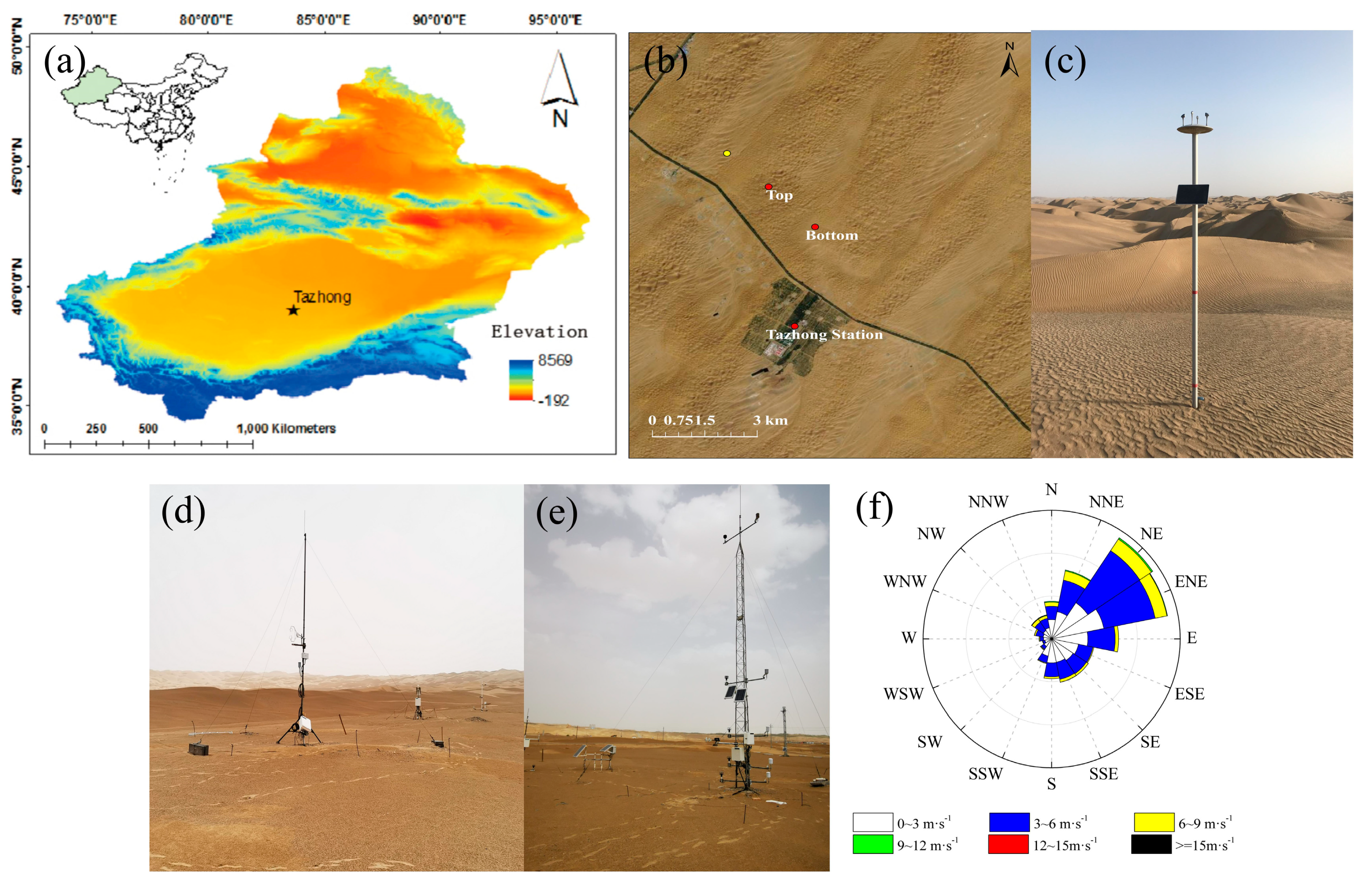
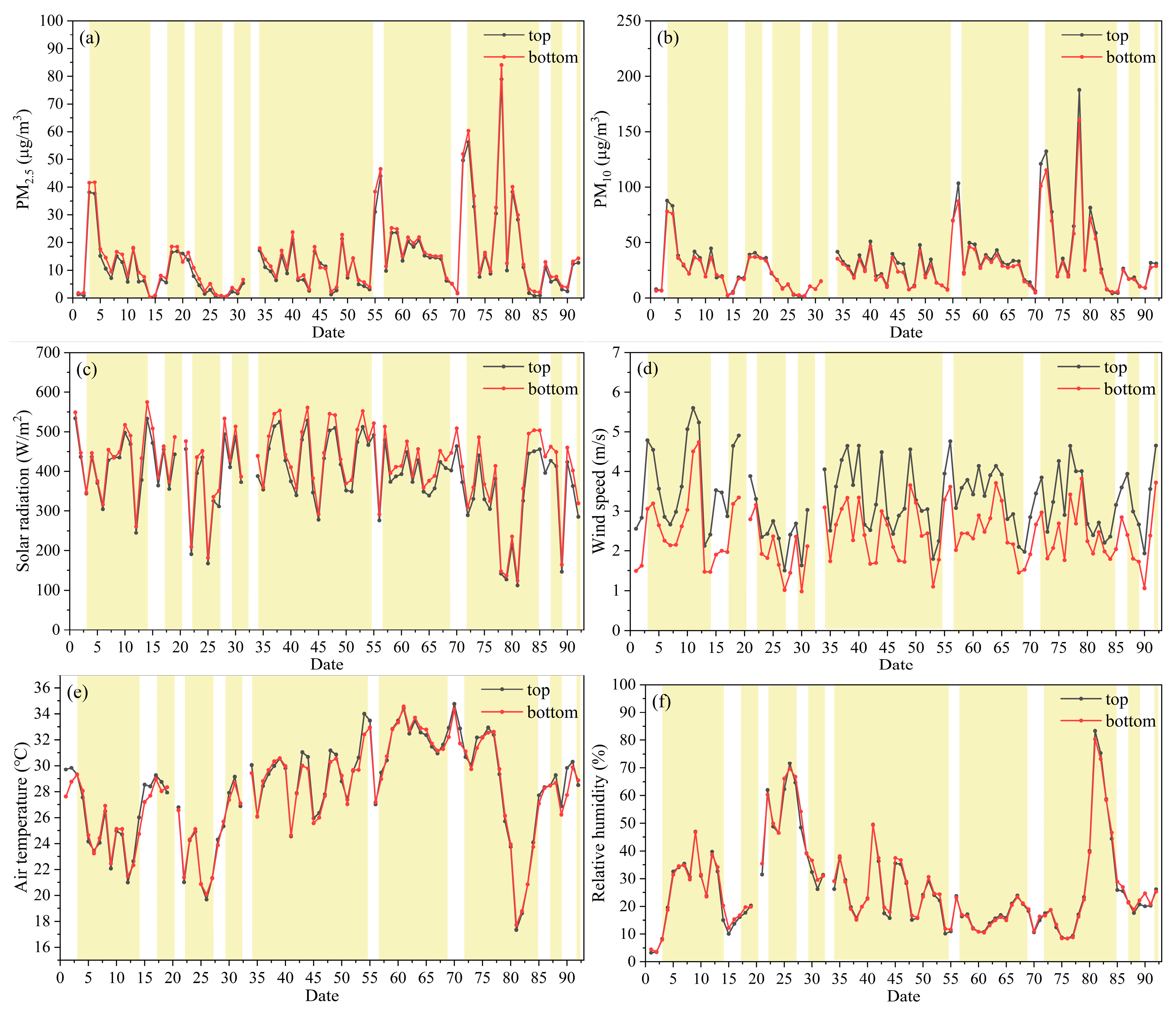
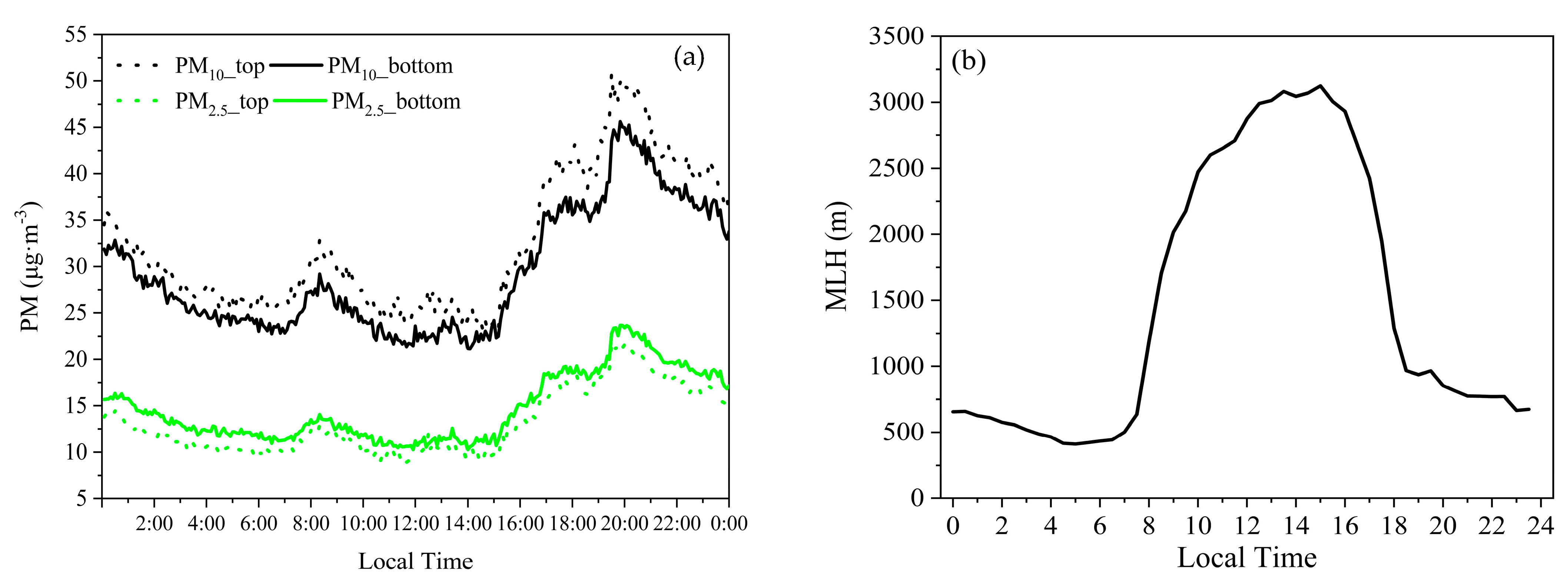

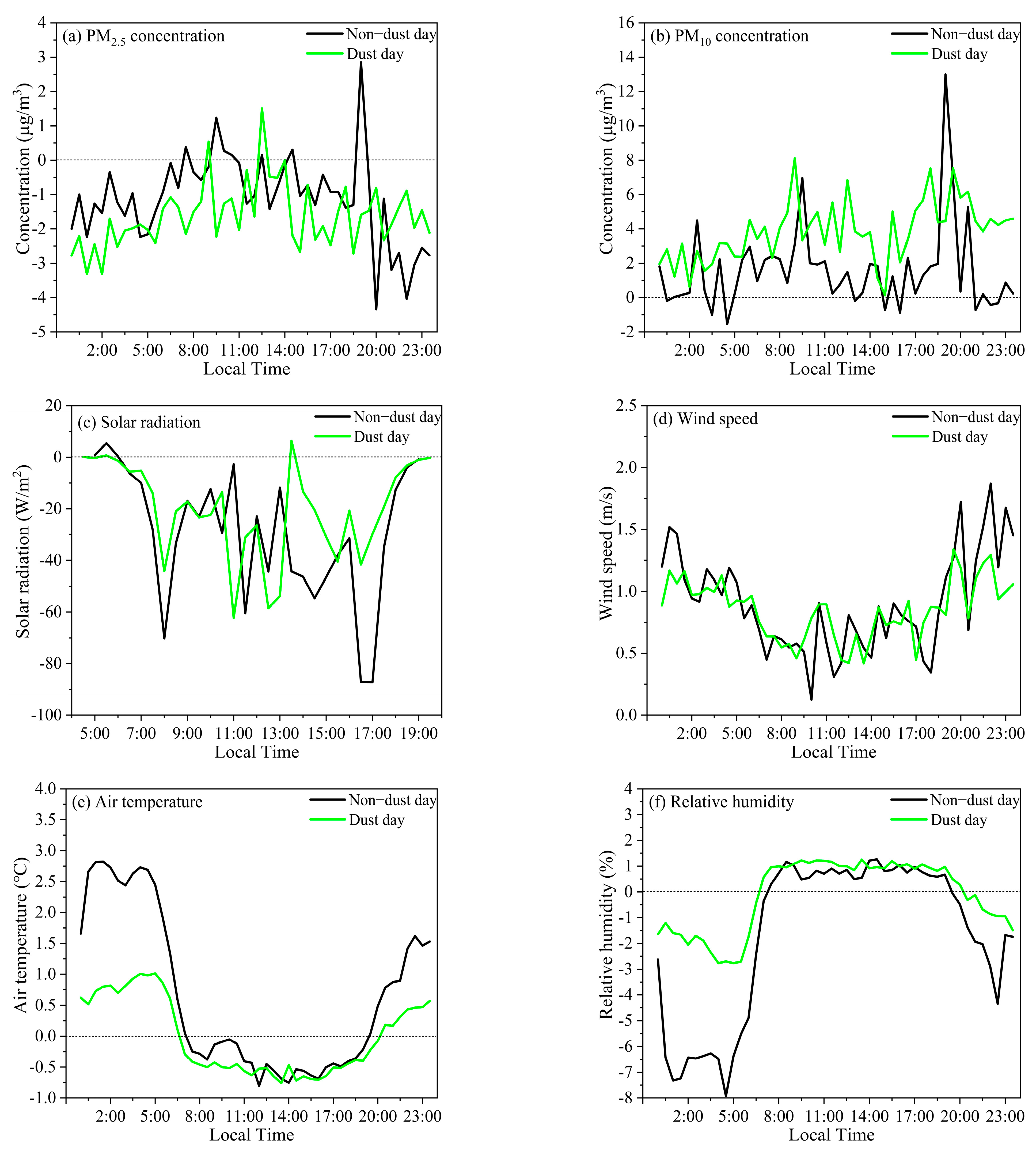
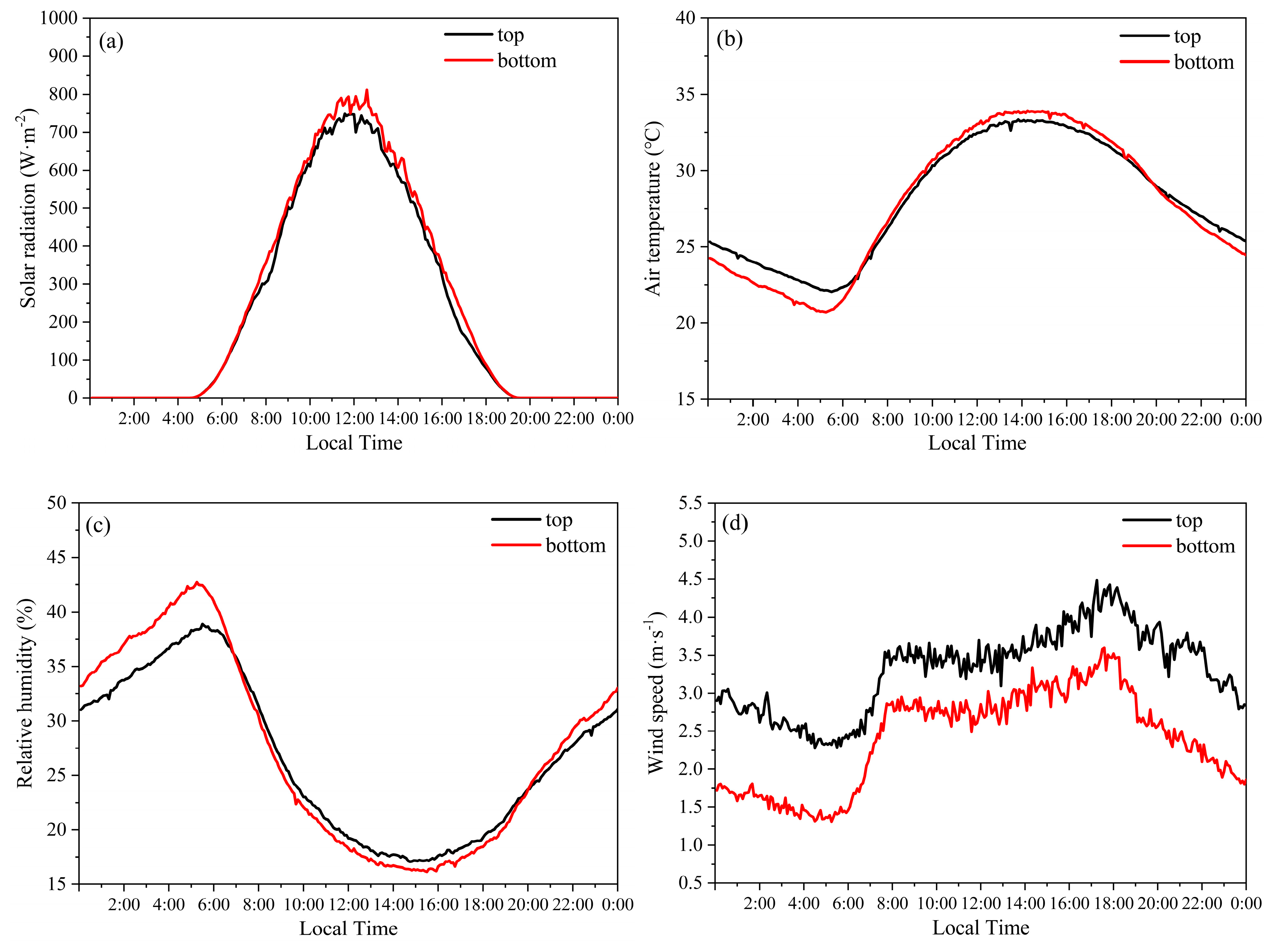
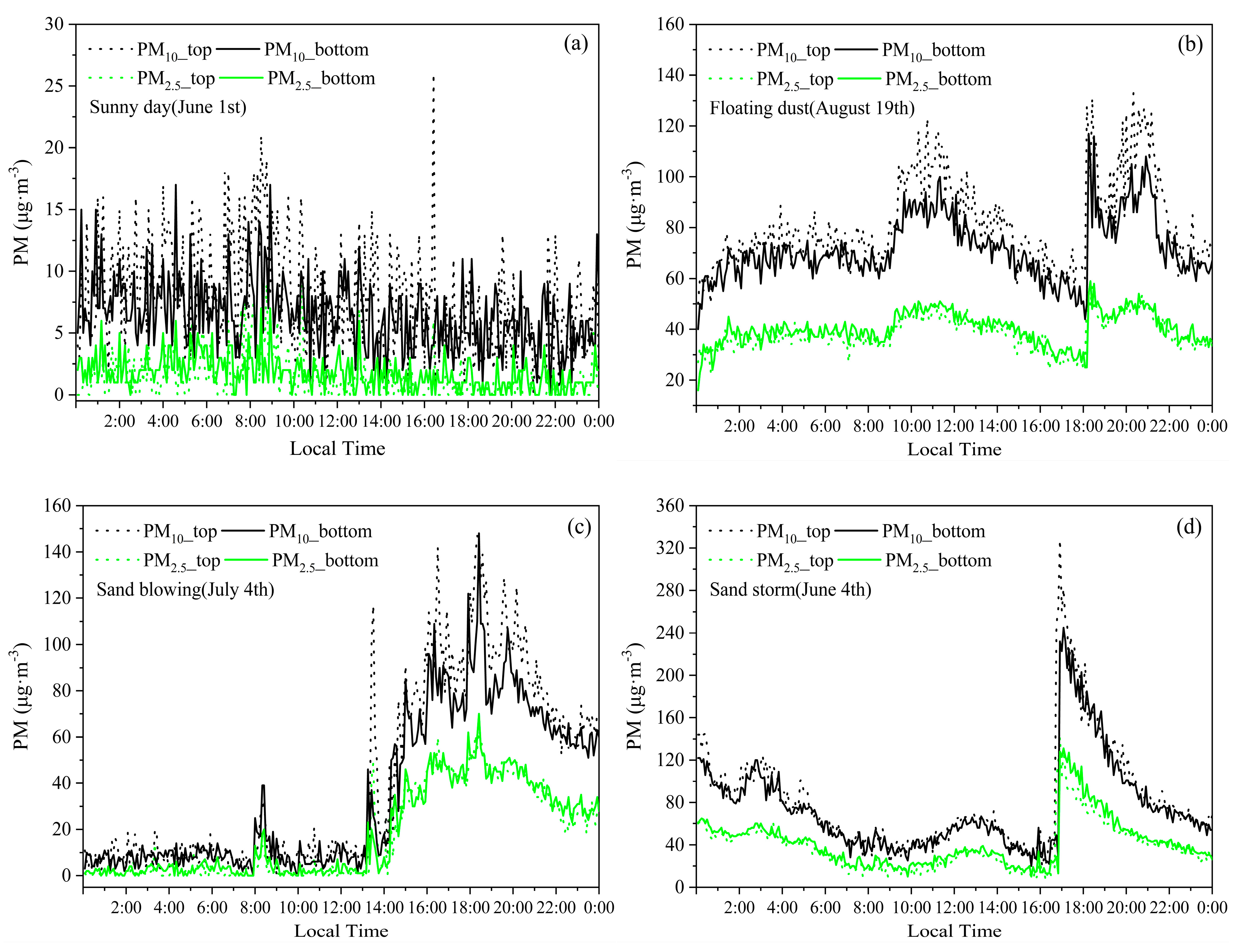
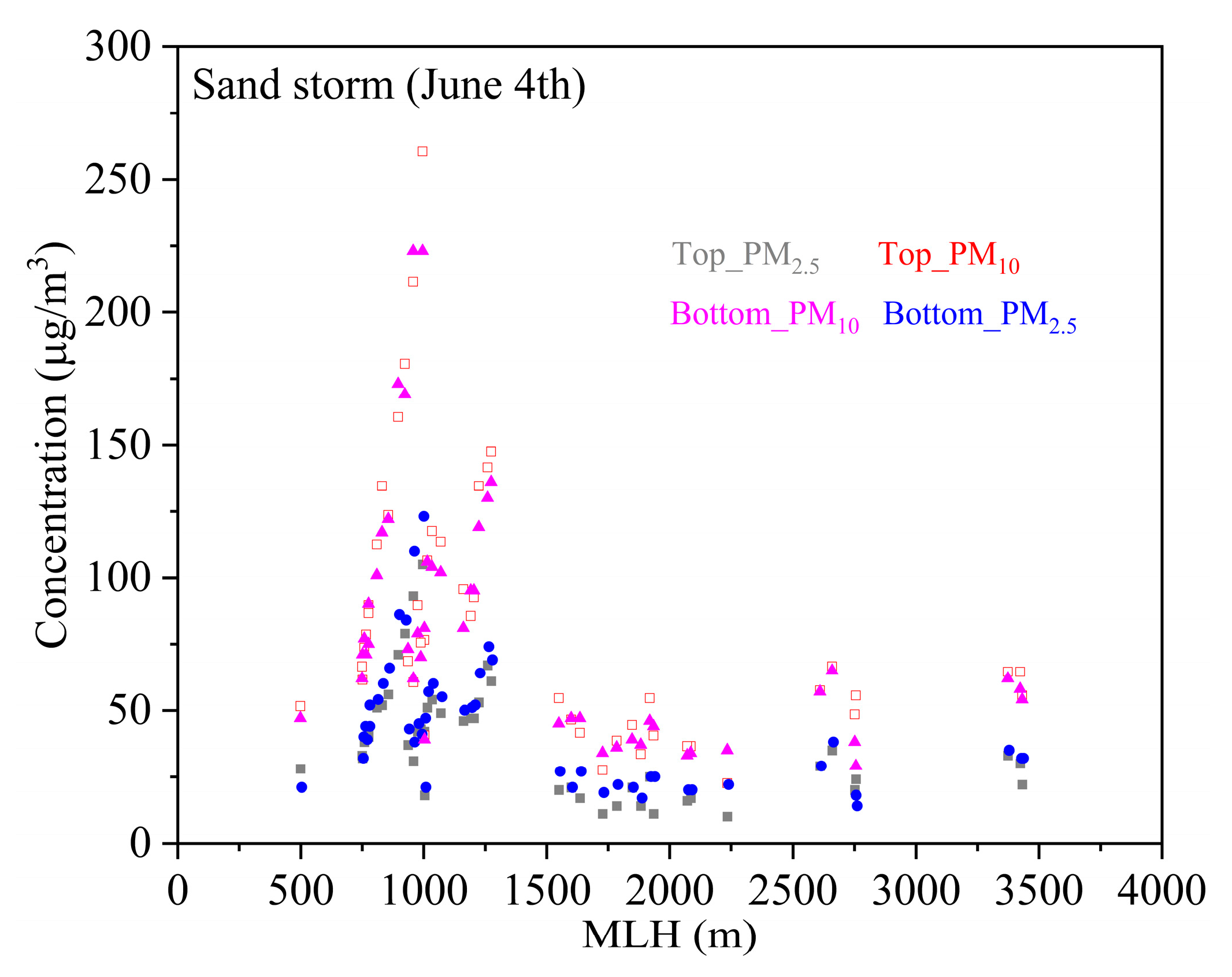
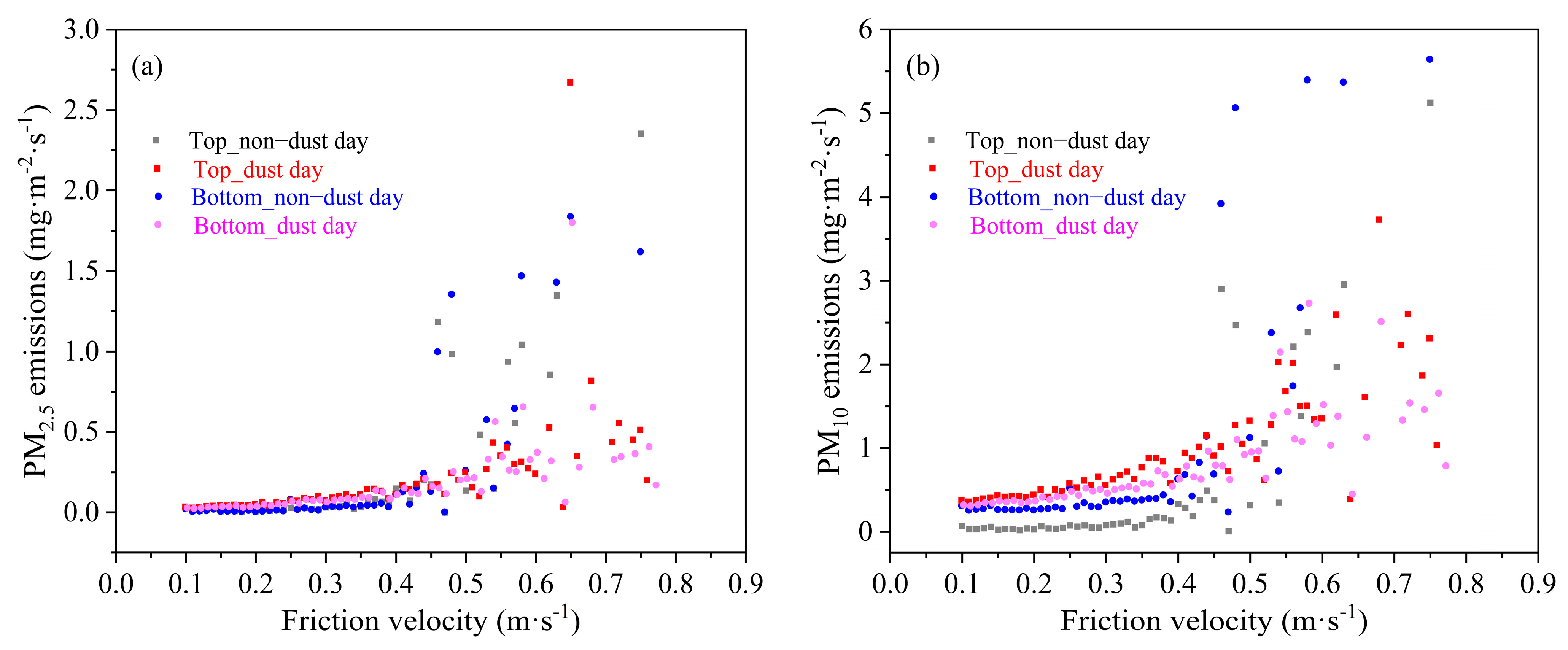
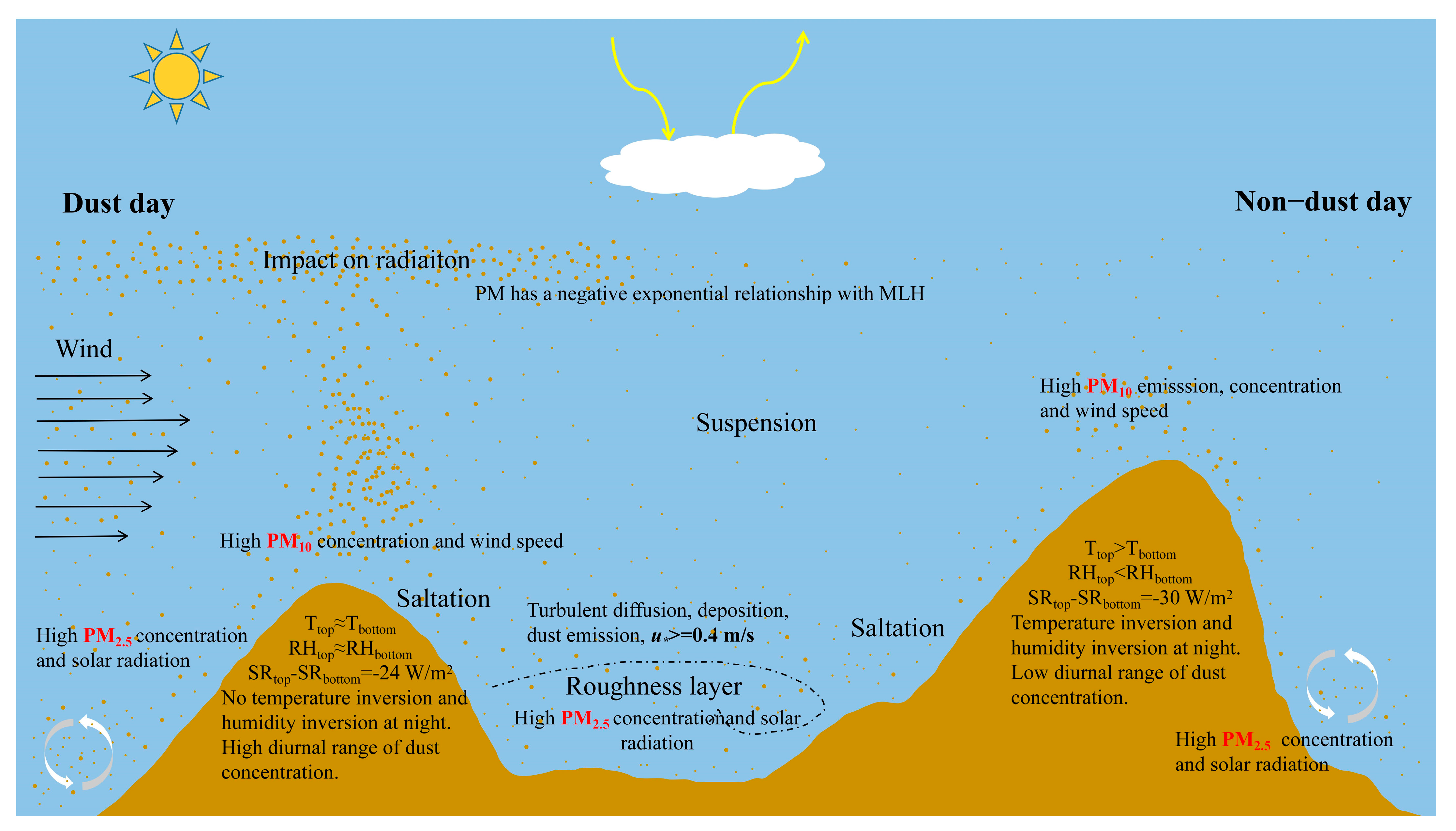

| PM2.5 /μg·m−3 | PM10 /μg·m−3 | SR /W·m−2 | T /°C | RH /% | WS /m·s−1 | |||||||
|---|---|---|---|---|---|---|---|---|---|---|---|---|
| Top | Bottom | Top | Bottom | Top | Bottom | Top | Bottom | Top | Bottom | Top | Bottom | |
| June | 8.8 | 10.6 | 24.1 | 22.6 | 241.9 | 254.7 | 25.3 | 25.2 | 32.5 | 33.4 | 3.3 | 2.4 |
| July | 13 | 14.4 | 31.9 | 28.7 | 253.5 | 268.8 | 29.7 | 29.5 | 22.7 | 23.4 | 3.4 | 2.5 |
| August | 17.8 | 18.8 | 40.4 | 36.1 | 194 | 211.4 | 29.2 | 29.0 | 24.7 | 24.9 | 3.2 | 2.4 |
| Average | 13.1 | 14.7 | 32.3 | 29.3 | 229 | 244.2 | 28.1 | 27.9 | 26.6 | 27.2 | 3.3 | 2.4 |
| PM2.5 /μg·m−3 | PM10 /μg·m−3 | SR /W·m−2 | T /°C | RH /% | WS /m·s−1 | |||||||
|---|---|---|---|---|---|---|---|---|---|---|---|---|
| Top | Bottom | Top | Bottom | Top | Bottom | Top | Bottom | Top | Bottom | Top | Bottom | |
| Non-dust day | 6.3 | 7.5 | 16.9 | 15.7 | 418 | 448.3 | 28.7 | 28.1 | 23.9 | 25.5 | 3 | 2 |
| The difference between top and bottom (non-dust day) | −1.2 | 1.2 | −30.3 | 0.6 | −1.6 | 1 | ||||||
| Dust day | 15.9 | 17.7 | 38.7 | 34.9 | 378.9 | 402.9 | 27.9 | 27.9 | 27.7 | 27.8 | 3.4 | 2.6 |
| The difference between top and bottom (dust day) | −1.8 | 3.8 | −24 | 0 | −0.1 | 0.8 | ||||||
Disclaimer/Publisher’s Note: The statements, opinions and data contained in all publications are solely those of the individual author(s) and contributor(s) and not of MDPI and/or the editor(s). MDPI and/or the editor(s) disclaim responsibility for any injury to people or property resulting from any ideas, methods, instructions or products referred to in the content. |
© 2023 by the authors. Licensee MDPI, Basel, Switzerland. This article is an open access article distributed under the terms and conditions of the Creative Commons Attribution (CC BY) license (https://creativecommons.org/licenses/by/4.0/).
Share and Cite
Jin, L.; He, Q. On the Association between Fine Dust Concentrations from Sand Dunes and Environmental Factors in the Taklimakan Desert. Remote Sens. 2023, 15, 1719. https://doi.org/10.3390/rs15071719
Jin L, He Q. On the Association between Fine Dust Concentrations from Sand Dunes and Environmental Factors in the Taklimakan Desert. Remote Sensing. 2023; 15(7):1719. https://doi.org/10.3390/rs15071719
Chicago/Turabian StyleJin, Lili, and Qing He. 2023. "On the Association between Fine Dust Concentrations from Sand Dunes and Environmental Factors in the Taklimakan Desert" Remote Sensing 15, no. 7: 1719. https://doi.org/10.3390/rs15071719
APA StyleJin, L., & He, Q. (2023). On the Association between Fine Dust Concentrations from Sand Dunes and Environmental Factors in the Taklimakan Desert. Remote Sensing, 15(7), 1719. https://doi.org/10.3390/rs15071719







